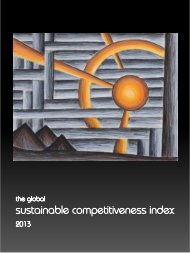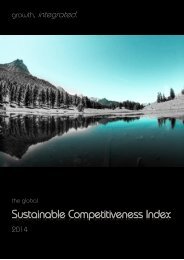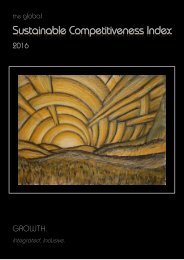The-Global-Sustainable-Competitiveness-Index-2015
Create successful ePaper yourself
Turn your PDF publications into a flip-book with our unique Google optimized e-Paper software.
Summary<br />
<strong>Sustainable</strong><br />
Competitive<br />
Natural<br />
Capital<br />
Social Capital<br />
Intellectual<br />
Capital<br />
Resource<br />
Management<br />
Governance Spotlight Data<br />
Methodology Details<br />
Data Sources<br />
Only data from reliable sources was included in the index. Most data points<br />
and data series were extracted from the World Banks statistical database as<br />
well as from the combined UN database that contains statistical data across<br />
several UN agencies.<br />
Data reliability & accuracy<br />
<strong>The</strong> accuracy of the index relies on the accuracy of the underlying data. Given<br />
the many individual and agencies involved in data collected around the<br />
World, it cannot be excluded that some of the data is not completely<br />
accurate. Data sources chosen for this <strong>Index</strong> (World Bank, UN agencies) are<br />
considered reasonably reliable. Raw data from the various databases was<br />
used as a basis for calculation as-is, i.e. without verifying the actual data.<br />
Limitations of quantitative analysis<br />
In order to exclude subjectivity, only quantitative data has been taken into<br />
account. However, quantitative indicators sometimes are not able to<br />
differentiate or express real and actual levels of quality. High spending on<br />
health care for example does not necessarily guarantee high quality health<br />
care system available for the average citizen. Equally, the percentage of<br />
school enrolment (on all levels, form primary levels to college and universities) is<br />
not necessarily an expression of the quality of the education. However, for<br />
some indicators, quality is equally important to quantity from a sustainability<br />
viewpoint. For such indicators, quantitative indicators have limited informative<br />
value and serve as a proxy.<br />
While explanatory power of quantitative indicators is limited, conducting a<br />
qualitative evaluation of the 73 indicators used on the global level would go far<br />
beyond the limitations of this index. For indicators with a potentially low<br />
correlation between quantity and quality, the weighting has been adjusted<br />
accordingly. In order to integrate some qualitative aspects, results of global<br />
surveys have been included, e.g. for the quality of public services, or perceived<br />
life satisfaction.<br />
Time frame of data used<br />
<strong>The</strong> <strong>Sustainable</strong> <strong>Competitiveness</strong> <strong>Index</strong> <strong>2015</strong> is based on the latest available<br />
data. For most data series, the latest data available (March 2013) is 2013 or<br />
2014 data. Where 2014 data was available, 2014 data has been used. Where<br />
2014 or 2013 data was not available, 2012 data was used, and in a few cases<br />
2011 data has been used.<br />
Availability of data<br />
For some indicators data is not available for all countries (in particular for the<br />
less or least developed economies). If non-available data points would be<br />
converted to a 0 (zero) score, the rankings would be distorted. In order to<br />
present a balanced overall picture, the missing data points from those<br />
countries have been replaced with calculated values, extrapolated based on<br />
regional averages, income and development levels, as well as geographical<br />
features and climatic averages.<br />
the sustainable competitiveness index <strong>2015</strong><br />
page 21








